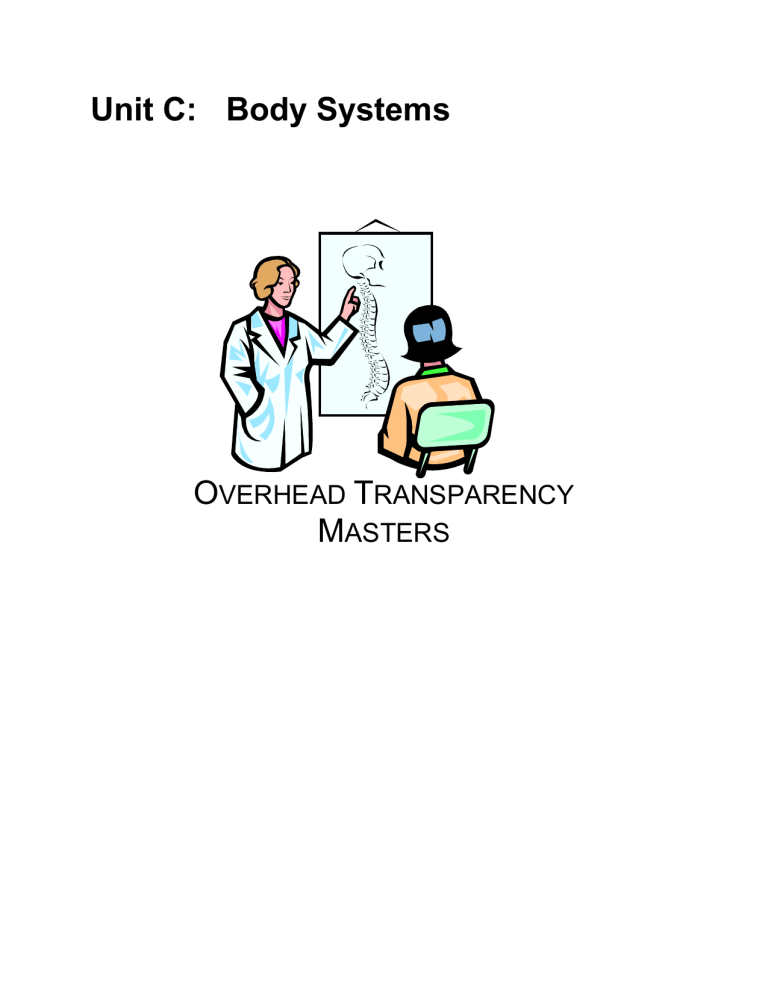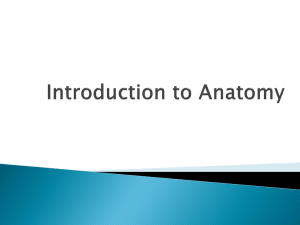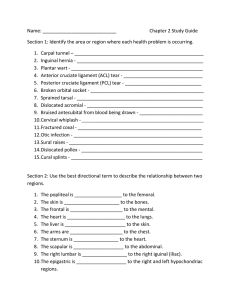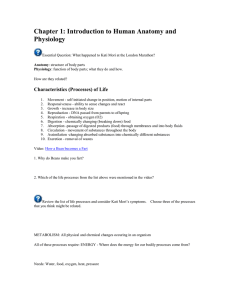
Unit C: Body Systems OVERHEAD TRANSPARENCY MASTERS ANATOMY – study of the parts of the body PHYSIOLOGY – function of the body ANATOMICAL POSITION – standing erect with face forward, arms at the side, palms forward Anatomic Terminology – Position and Direction ANTERIOR or VENTRAL – front or in front of POSTERIOR or DORSAL – back or in back of CRANIAL – refers to the head of the body CAUDAL – means tail end SUPERIOR – upper or above something INFERIOR – lower or below something MEDIAL – toward the middle LATERAL – toward the side of the body PROXIMAL – toward the point of attachment to the body or the trunk of the body DISTAL – away from the point of attachment to the body SUPERFICIAL (EXTERNAL) – near the surface or outside the body DEEP (INTERNAL) – inside the body Body Planes and Sections PLANES – imaginary anatomical dividing planes SECTION – cut made through the body in the direction of a certain plane SAGITTAL PLANE – divides the body into right and left parts CORONAL (FRONTAL) PLANE – vertical cut at right angles to saggital plane, divides the body into anterior and posterior portions TRANSVERSE PLANE – cross-section, a horizontal cut that divides the body into upper and lower parts Cavities of the Body DORSAL CAVITY – contains brain and spinal cord – the brain is in the CRANIAL CAVITY and the spinal cord is in the SPINAL CAVITY. ANTERIOR or VENTRAL CAVITY contains the THORACIC and ABDOMINOPELVIC CAVITIES The thoracic cavity contains the lungs and heart ABDOMINAL CAVITY contains stomach, intestines, liver, gallbladder and pancreas PELVIC CAVITY contains urinary bladder and reproductive organs Abdominopelvic Cavity Regions L Hypochondriac Epigastric L Hypochondriac Umbilical R Lumbar R Inguinal L Lumbar Hypogastric L Inguinal Tissues TISSUES – cells grouped because they are similar in shape, size, structure, and function EPITHELIAL TISSUE – protects the body by covering internal and external surfaces, and produces secretions CONNECTIVE TISSUE – supports and connects organs and tissue MUSCLE TISSUE – has the ability to contract and move the body NERVOUS TISSUE – cells that react to stimuli and conduct an impulse ADIPOSE TISSUE – type of connective tissue that stores fat cells LIGAMENTS – strong, flexible bands of connective tissue that hold bones firmly together at the joints TENDONS – white bands of connective tissue attaching skeletal muscle to bone CARTILAGE – firm, flexible support of the embryonic skeleton and part of the adult skeleton MEMBRANES – formed by putting two thin layers of tissue together, cells may secrete a fluid MUCOUS MEMBRANES– lines digestive, respiratory, reproductive and urinary systems – produces mucous to lubricate and protect the lining SEROUS MEMBRANES – double-walled membrane - produces a watery fluid, lines closed body cavities 1. the outer part of the membrane that lines the cavity is the PARIETAL membrane 2. the part that covers the organs is the VISCERAL membrane. PLEURAL MEMBRANE – lines thoracic or chest cavity and protects the lungs PERICARDIAL MEMBRANE – lines the heart cavity and protects the heart PERITONEAL MEMBRANE – lines the abdominal cavity and protects abdominal organs Organs and Systems ORGAN SYSTEM – a group of organs which act together to perform a specific, related function Integumentary Skeletal Muscular Digestive Respiratory Circulatory Excretory Nervous Endocrine Reproductive







